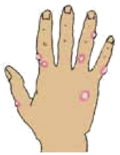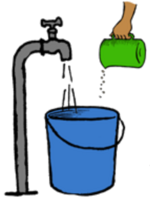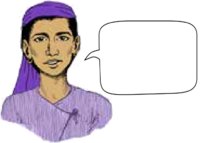Hesperian Health Guides
Mpox (Monkeypox)
Mpox (also known as monkeypox) is a disease caused by the mpox virus that spreads between people. Previously common in only a few regions, mpox is now spreading to new areas. People with mpox can have skin rashes with fever, headaches and body aches. Some people also have a sore throat and cough, and feel very weak and tired.

Rashes appear as fluid-filled bumps. Bumps usually start on the tongue or mouth and then spread to other parts of the body including the face, palms of the hands, arms, soles of the feet, and genitals. The rash usually breaks out on the arms and legs, but also may happen anywhere on the body. A person can have mpox virus for up to 2 weeks before showing any signs.
Most people who get mpox recover in 2 to 4 weeks. The rash is painful, and will begin to itch, burst and then scab over. If scratched, the rash can get infected, take longer to heal and leave scars.
Contents
How does mpox virus spread?
Mpox virus can enter the body through the eyes, nose, mouth or anywhere skin is cut, scratched or cracked. The virus can spread when fluid inside the rash is passed from one person to another. Even mostly dry or crusty scabs can still contain infectious virus.
Mpox virus is passed through:
- Direct contact. Touching a person who has mpox, including shaking hands, hugging, kissing, dancing, having sex, and massaging.
- Indirect contact. Sharing bedding, towels, clothing, utensils, mobile phones, slippers or other objects that have come into contact with fluid from the rash of a person who has mpox.
Mpox virus may enter a person’s body through respiration (coughing, sneezing, breathing) if someone spends a long time (usually 3 hours or more) very close to a person infected with the virus.
Who does mpox virus infect?
Anyone can get infected where there is an outbreak of mpox. Children and people with weakened immune systems are at greater risk of severe illness from mpox virus. People who have been vaccinated against smallpox virus (similar to, but much worse than mpox virus) are less likely to get it.
Treatment
Mpox can be treated at home with bed rest and drinking plenty of fluids and will go away on its own in 2 to 4 weeks. Paracetamol (acetaminophen) can reduce fever and pain from rashes. To calm the itchiness of skin rashes:

- Bathe rashy skin with cool water, or water in which oatmeal has been soaked.
- Gently pat skin dry after bathing. It is OK if skin feels damp.
- Apply calamine lotion several times a day to calm itching. For severe itching, use 1% hydrocortisone cream on skin.
- Apply neem tree oil to soothe inflamed skin.
- Leave skin open to the air to encourage drying. When near people, wear loose clothing that keeps rashy skin airy but covered.
Get emergency help if infection spreads to the eyes or inside the genitals or anus, or for a high fever (above 39.4°C/ 103°F in adults, or 38.9°C/ 102°F in children) and medicines for fever are not helping.
Vaccine and vaccine inequality
- Two vaccines created to protect against smallpox virus, ACAM2000 and JYNNEOS (also known as Imvamune or Imvanex), can also work against mpox. People who have a weakened immune system, eczema or are pregnant should not use ACAM2000.
- People who live and work in crowded conditions in communities where there is an outbreak and health workers treating people with mpox need vaccines. Wealthy countries are buying up and stocking these vaccines. Vaccines must be distributed to all people with the greatest need instead of being reserved for those with the greatest wealth.

Prevent the spread of mpox virus
- People with mpox should isolate from others until their scabs have completely fallen off.
- If you will have prolonged, direct contact with a person who has mpox, wear gloves and a clean, dry mask that covers the mouth and nose completely.
- Wear protective gloves to wash clothing and bedding of a person with mpox. Avoid shaking soiled clothes. Keep their washing separate from others, and use detergent and hot water, if available. Dry in direct sunlight. Discard gloves properly as they may be contaminated.
- Wash eating utensils with warm soapy water. Avoid sharing utensils.
- Wash hands frequently with soap and water or an alcohol-based handrub. Always wash hands when returning home, after using the bathroom, before meals, and after coughing, sneezing or blowing your nose. Avoid touching your face without first washing your hands.

| Health workers caring for people with mpox virus should wear protective equipment, including masks, gloves, face shields, and cloth coats, gowns or aprons when in direct contact with these patients for long periods of time. |


